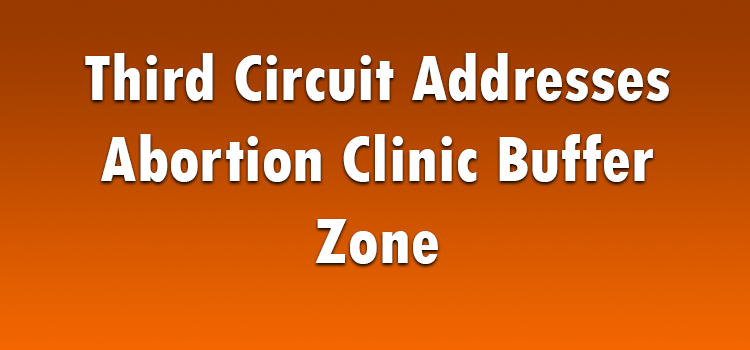In Turco v. City of Englewood, the Third Circuit addressed when abortion clinic buffer zones run afoul of the U.S. Constitution. It held that the lower court erred in striking down an Englewood ordinance intended to deter “sidewalk counseling” of women entering an abortion clinic.

Facts of Turco v. City of Englewood
In March 2014, the City Council of Englewood (City) amended its ordinances to address aggressive antiabortion protests that had been regularly occurring outside of Metropolitan Medical Associates (MMA). Many of these protestors were associated with an evangelical ministry called the Bread of Life, which had ties to other radical antiabortion organizations including those which support violent reprisal against abortion providers.
The new ordinance (Ordinance) had the practical effect of establishing three overlapping buffer zones at any qualifying facility. Two semicircular buffer zones extended outwards eight feet from either side of the facility’s entrance. The third buffer zone spanned the width of the facility’s entrance and extended to the street.
Plaintiff Jeryl Turco was not one of the hostile or aggressive anti-abortion protestors. Rather, she refers to herself as a “sidewalk counselor,” and her practice was to calmly approach women entering the clinic and attempt to engage in peaceful, nonconfrontational communication.
Turco filed suit against the City of Englewood pursuant to 42 U.S.C. § 1983 to enjoin enforcement of the Ordinance. She alleged that the Ordinance violated her First Amendment rights to freedom of speech, assembly, and association. She sought a declaration that the Ordinance was unconstitutional on its face and as applied and sought to enjoin its enforcement.
The District Court struck down the Ordinance, concluding that it was overbroad and not narrowly tailored to serve the government’s interest. According to the court, the City “did not create a targeted statute to address the specific issue of congestion or militant and aggressive protestors outside of the Clinic.” Rather, it found that the City had “created a sweeping regulation that burdens the free speech of individuals, not just in front of the Clinic, but at health care and transitional facilities citywide.”
Third Circuit’s Decision in Turco v. City of Englewood
The Third Circuit concluded that there were genuine issues of material fact precluding the entry of summary judgment to either side. Accordingly, it reversed and remanded for further proceedings.
As highlighted by the Third Circuit, for a content-neutral speech restriction such as the Ordinance to be narrowly tailored, it must not burden substantially more speech than is necessary to burden the government’s legitimate interests. Like the district court, the Third Circuit relied on McCullen v. Coakley, 573 U.S. ___ (2014). In McCullen, a sidewalk counselor sued to enjoin enforcement of a Massachusetts statute that made it a crime to stand within thirty-five feet of the entrance of any place where abortions were performed. The U.S. Supreme Court ruled the statue was unconstitutional because it placed too great a burden on the McCullen’s First Amendment Rights.
While the Third Circuit agreed that McCullen controlled, it found that the district court failed to recognize key distinctions between the two cases. As Judge Theodore McKee explained:
First, the buffer zones’ exact impact on the sidewalk counselors’ speech and the concomitant efficacy of their attempts to communicate is unclear on this record. Indeed, Turco admitted that she continued to speak with patients entering the clinic after the enactment of the buffer zones. At the very least, there is contradictory evidence regarding the extent to which the buffer zone prevented Turco from communicating her message as she wanted. Second, the record—properly viewed in the light most favorable to the City— established that the City considered and attempted to implement alternative means of regulating speech, and that the City did attempt to enforce existing laws before creating the buffer zone. Those measures failed.
Based on the foregoing, the Third Circuit rejected the district court’s conclusion that Turco was entitled to judgment as a matter of law.
